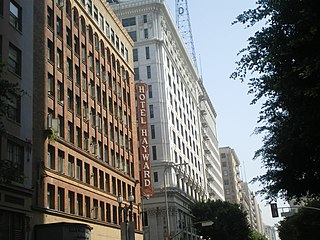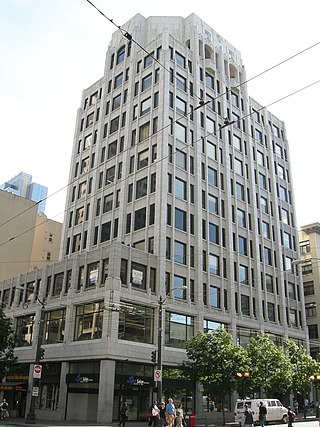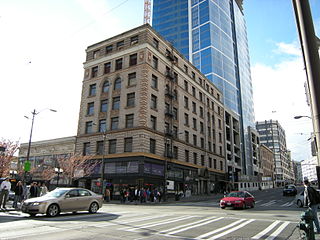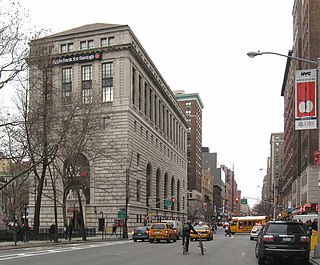
The Wrigley Building is a skyscraper located at 400–410 North Michigan Avenue on Chicago's Near North Side. It is located on the Magnificent Mile directly across Michigan Avenue from the Tribune Tower. Its two towers in an elaborate style were built between 1920 and 1924 to house the corporate headquarters of the Wrigley Company. Its bright white facade is covered in terra cotta.

The Pioneer Building is a Richardsonian Romanesque stone, red brick, terra cotta, and cast iron building located on the northeast corner of First Avenue and James Street, in Seattle's Pioneer Square District. Completed in 1892, the Pioneer Building was designed by architect Elmer Fisher, who designed several of the historic district's new buildings following the Great Seattle Fire of 1889.

The Bank of Italy Building, also known as the Clay-Montgomery Building, is a building in San Francisco, California. This eight-story building became the headquarters of A. P. Giannini's Bank of Italy in 1908 after the 1906 San Francisco earthquake and fire destroyed the original bank building on Montgomery Avenue in the nearby neighborhood of North Beach. The building was designated a National Historic Landmark in 1978 for its association with Giannini, who revolutionized retail banking in the early 20th century.
The Studebaker Building is a former structure at 1600 Broadway on the northeast corner at 48th Street in Manhattan, New York City. It was erected by the Juilliard Estate, in 1902, between Broadway and 7th Avenue, in the area north of Times Square. It was demolished in 2004 to make room for an apartment tower, a twenty- five story, 136 unit, luxury condominium designed by architect Einhorn Yaffee Prescott.

Spring Street in Los Angeles is one of the oldest streets in the city. Along Spring Street in Downtown Los Angeles, from just north of Fourth Street to just south of Seventh Street is the NRHP-listed Spring Street Financial District, nicknamed Wall Street of the West, lined with Beaux Arts buildings and currently experiencing gentrification. This section forms part of the Historic Core district of Downtown, together with portions of Hill, Broadway, Main and Los Angeles streets.

The Federal Office Building, Seattle, Washington is a historic federal office building located at Seattle in King County, Washington.

The Detroit Financial District is a United States historic district in downtown Detroit, Michigan. The district was listed on the U.S. National Register of Historic Places on December 14, 2009, and was announced as the featured listing in the National Park Service's weekly list of December 24, 2009.

The Pershing Square Building, also known as 125 Park Avenue or 100 East 42nd Street, is a 25-story office building in Midtown Manhattan in New York City. It is located on the eastern side of Park Avenue between 41st and 42nd streets, across from Grand Central Terminal to the north and adjacent to 110 East 42nd Street to the east.

The Colman Building is a historic office building on First Avenue in downtown Seattle, Washington. It occupies a half of a block in proximity to Pioneer Square, and is bound by First Avenue, Marion, and Columbia Streets. It is listed on the National Register of Historic Places and is a City of Seattle landmark.

The Olympic Tower, originally known as the United Shopping Tower, then the Northwestern Mutual Insurance Building, and later, the Olympic Savings Tower, is a historic 12-story office tower located in Seattle, Washington and listed on the National Register of Historic Places. It was originally built in 1929 at the Southwest corner of Third Avenue and Pine Street for the United Pacific Corporation under the control of Seattle investment firm Drumheller, Ehrlichman and White. It was designed by Henry Bittman who would also design additions to the building in 1939.

The Holyoke Building is a historic building located in downtown Seattle, Washington. It is a substantial five story brick structure with stone trimmings. Construction began at the corner of First Avenue and Spring Streets just before the Great Seattle fire of 1889. Completed in early 1890, it was among the first permanent buildings completed and ready for occupancy in downtown Seattle following the fire. Today the Holyoke Building is one of the very few such buildings still standing in Seattle outside of the Pioneer Square district and is a historic remnant of the northward expansion of Seattle's business district between the time of the great fire and the Yukon Gold Rush in 1897.

The United States National Bank Building in downtown Portland, Oregon was designed by A. E. Doyle in a Roman classical style, and is listed on the National Register of Historic Places. The four-story building's first section, facing Sixth Avenue, was completed and opened in 1917. The building features a four-story Corinthian colonnade at its eastern end and makes extensive use of glazed terracotta. The interior is also decorated extensively with highly textured materials.

The Federal Reserve Bank Building, also known as the Federal Reserve Bank of San Francisco, Seattle Branch, served as the offices of the Seattle branch of the Federal Reserve Bank of San Francisco for over 50 years, from 1951 to 2008.

The New Center Commercial Historic District is a commercial historic district located on Woodward Avenue between Baltimore Street and Grand Boulevard in Detroit, Michigan. It was listed on the National Register of Historic Places in 2016.

The Eitel Building is an eight-story hotel building at the corner of Pike Street and 2nd Avenue in Downtown Seattle, Washington, United States. Originally built by the Eitel Brothers in 1904 to house medical offices, the building had been mostly vacant since the 1970s and described as an eyesore. In 2016, after several attempted purchases by local developers, the Eitel Building was sold to a development company that announced its intent to convert the building into a boutique hotel. The hotel renovation, which also added the eighth floor, cost $16 million and was completed in early 2019.

110 East 42nd Street, also known as the Bowery Savings Bank Building, is an 18-story office building in Midtown Manhattan, New York City. The structure was designed in the Italian Romanesque Revival style by York and Sawyer, with William Louis Ayres as the partner in charge. It is on the south side of 42nd Street, across from Grand Central Terminal to the north and between the Pershing Square Building to the west and the Chanin Building to the east. 110 East 42nd Street is named for the Bowery Savings Bank, which had erected the building as a new branch structure to supplement its original building at 130 Bowery. The building was erected within "Terminal City", a collection of buildings above the underground tracks surrounding Grand Central, and makes use of real-estate air rights above the tracks. The building is directly above the New York City Subway's Grand Central–42nd Street station.

The Interurban Building, formerly known as the Seattle National Bank Building (1890–1899), the Pacific Block (1899–1930) and the Smith Tower Annex (1930–1977), is a historic office building located at Yesler Way and Occidental Way S in the Pioneer Square neighborhood of Seattle, Washington, United States. Built from 1890 to 1891 for the newly formed Seattle National Bank, it is one of the finest examples of Richardsonian Romanesque architecture in the Pacific Northwest and has been cited by local architects as one of the most beautiful buildings in downtown Seattle. It was the breakthrough project of young architect John Parkinson, who would go on to design many notable buildings in the Los Angeles area in the late 19th and early 20th century.

The Greenwich Savings Bank Building, also known as the Haier Building and 1356 Broadway, is an office building at 1352–1362 Broadway in the Midtown Manhattan neighborhood of New York City. Constructed as the headquarters of the Greenwich Savings Bank from 1922 to 1924, it occupies a trapezoidal parcel bounded by 36th Street to the south, Sixth Avenue to the east, and Broadway to the west. The Greenwich Savings Bank Building was designed in the Classical Revival style by York and Sawyer.

The Williamsburgh Savings Bank Building, also known as the Weylin and 175 Broadway, is a former bank building at 175 Broadway in the Williamsburg neighborhood of Brooklyn in New York City. Constructed as the headquarters of the Williamsburgh Savings Bank in 1875 and subsequently expanded several times, it occupies the northwest corner of Broadway and Driggs Avenue, just south of the Williamsburg Bridge. The Williamsburgh Savings Bank Building was designed in the Classical Revival style by George B. Post, with interiors by Peter B. Wight.

The Apple Bank Building, also known as the Central Savings Bank Building and 2100 Broadway, is a bank and residential building at 2100–2114 Broadway on the Upper West Side of Manhattan in New York City. Constructed as a branch of the Central Savings Bank from 1926 to 1928, it occupies a trapezoidal city block bounded by 73rd Street to the south, Amsterdam Avenue to the east, 74th Street to the north, and Broadway to the west. The Apple Bank Building was designed by York and Sawyer in the Renaissance Revival and palazzo styles, patterned after an Italian Renaissance-style palazzo.





















